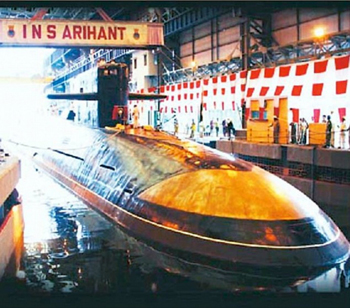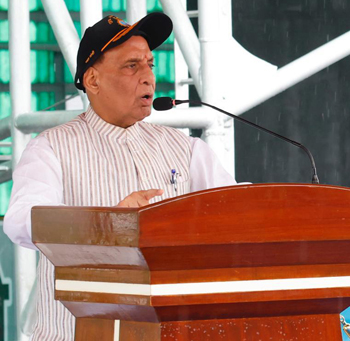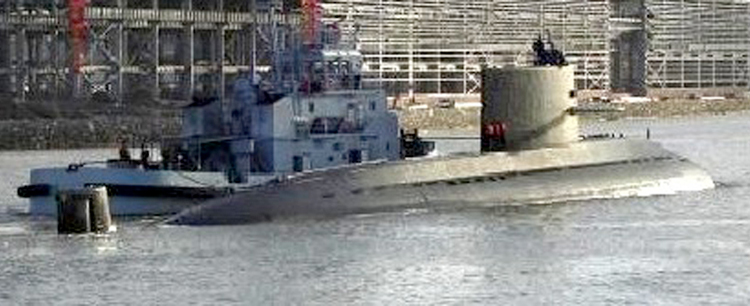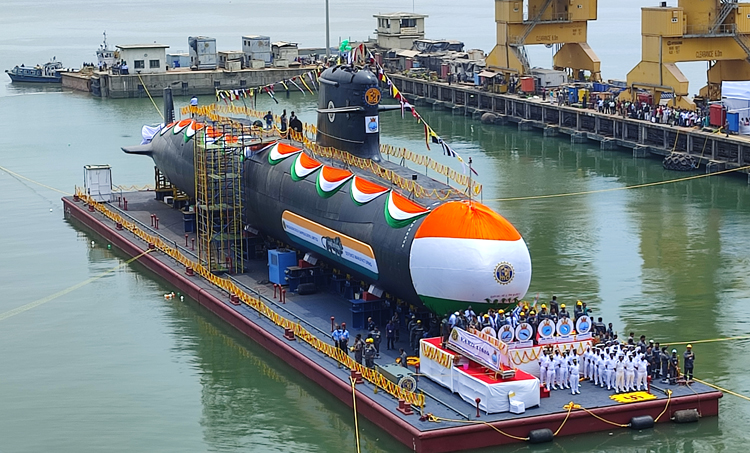INDIAN ARMED FORCES CHIEFS ON OUR RELENTLESS AND FOCUSED PUBLISHING EFFORTS

The insightful articles, inspiring narrations and analytical perspectives presented by the Editorial Team, establish an alluring connect with the reader. My compliments and best wishes to SP Guide Publications.

"Over the past 60 years, the growth of SP Guide Publications has mirrored the rising stature of Indian Navy. Its well-researched and informative magazines on Defence and Aerospace sector have served to shape an educated opinion of our military personnel, policy makers and the public alike. I wish SP's Publication team continued success, fair winds and following seas in all future endeavour!"

Since, its inception in 1964, SP Guide Publications has consistently demonstrated commitment to high-quality journalism in the aerospace and defence sectors, earning a well-deserved reputation as Asia's largest media house in this domain. I wish SP Guide Publications continued success in its pursuit of excellence.
- Operation Sindoor: Resolute yet Restrained
- India’s Operation Sindoor Sends a Clear Message to Terror and the World – ‘ZERO TOLERANCE’
- Japan and India set forth a defence cooperation consultancy framework, talks on tank and jet engines
- Terrorist Attack in Pahalgam in Kashmir: Unfolding a long surgical war against PAK
- Lt General Pratik Sharma takes over Command of Indian Army's Northern Command
India's Nuclear–Powered Submarines
The SSNs will be 10,000-tonne vessels, powered by advanced pressurized water nuclear reactors, equipped with torpedoes and cruise missiles, and will feature endurance and stealth capabilities, making them difficult to detect and ideal for power projection
 |
The Author is Former Director General of Information Systems and A Special Forces Veteran, Indian Army |

On October 9, 2024, the Cabinet Committee on Security (CCS), headed by Prime Minister Narendra Modi, approved the construction of the first two nuclear-powered attack submarines, of a planned six such submarines for the Indian Navy. This is a crucial homegrown SSN project for the Indian Navy, which has been dependent on a critically low fleet of conventional diesel-electric submarines since the past several years. Ironically, the CCS approval came after the Indian Navy sent this proposal nearly five years ago.
The Indian Navy has had experience of operating SSNs earlier on two occasions – with SSNs leased from Russia. The first SSN, INS 'Chakra', was a Charlie-class submarine that operated from 1987 to 1991. The second SSN, also named INS 'Chakra', was an Akula-class submarine that operated from 2011 to 2021. Leasing of a second Akula-class submarine from Russia is already in the works.
The Indian Navy's SSN project aims to enhance its capabilities with long-endurance submarines for ocean dominance and anti-submarine operations, complementing the existing indigenous ballistic missile submarines, INS Arihant and INS Arighaat.
The Indian Navy is already operating two indigenous nuclear-powered ballistic missile submarines (SSBN), INS 'Arihant' and INS 'Arighaat', which are part of India's nuclear deterrent. But the SSN project is seeking long endurance submarines for regular naval use; to dominate the ocean territory and hunt enemy submarines and vessels. India has a coastline of over 7,500 km, including 6,100 km along the mainland surrounded by the Arabian Sea in the west, Bay of Bengal in the east and Indian Ocean on the South; an enormous area of responsibility.

The SSNs approved to be built will reportedly be of 6,000-tonne capacity and will be powered by pressure water nuclear power reactors more capable than the type powering the two SSBNs in service. The plan is to build the two SSNs at the Ship Building Centre (SBC) in Visakhapatnam, with each costing around ₹16,000 crore. Like the follow-on SSBNs, the knowledge gained from the early SSBN programme will help with the SSN project, proving that the SSBN initiative is really making headway. As with the SSBN programme, Indian private sector giant Larsen and Toubro (L&T) would lead the development of the SSNs. However, these two SSNs will be of 10,000-tonne capacity – 40 percent bigger than similar Chinese Type 093 Shang-class submarines deployed in the Indian Ocean Region. These SSNs will be equipped with torpedoes and anti-ship/land attack cruise missiles. SSNs are faster, have longer endurance, and can remain submerged for months, making them ideal for sustained surveillance, deterrence, and power projection. They are difficult to detect and can carry a range of weapons, from torpedoes to cruise missiles, thus providing India with the ability to respond to threats both on and beneath the sea.
India faces significant challenges in the Indian Ocean Region from China's expanding naval presence, with the Chinese People's Liberation Army Navy (PLAN) operating six nuclear-powered attack submarines and regularly patrolling the region.
SSNs are considered the backbone of naval capability because of their versatility in both offensive and defensive roles. They can operate as 'silent hunters' to stalk enemy vessels, including surface ships and submarines, without being detected. In addition, SSNs are capable of launching precise strikes on land targets using cruise missiles. This gives them an edge in both naval battles and land-attack missions, further enhancing India's combat capabilities.

The main challenge to the Indian Navy in the Indian Ocean Region is from China and Pakistan. China has the largest navy in the world with 370 platforms. China sports an expanding SSN fleet and the Chinese People's Liberation Army Navy (PLAN) has been increasing its naval presence in the Indian Ocean with Chinese nuclear and conventional submarines regularly patrolling the Indian Ocean. China is also continuously adding advanced nuclear vessels to its fleet. China's newest Zhou-class nuclear submarine sank earlier this year. However, aaccording to the latest China military power report from 2023, the PLAN operates six nuclear-powered ballistic missile submarines, six nuclear-powered attack submarines, and 48 diesel-powered attack submarines. It is the third largest submarine force in the world with 60 submarines; after Russia with 65 and the US with 64 submarines.
Indigenous development of SSNs is crucial for India to mitigate strategic vulnerabilities, avoid dependence on foreign suppliers for spare parts and maintenance, and strengthen its deterrence capabilities amid growing geopolitical tensions.
By contrast, the Indian Navy currently operates 14 conventionally powered diesel-electric submarines and two nuclear-powered submarines, adding up to a total operational submarine strength of 16. Compared to the SSNs, the diesel-electric submarines are limited in range and endurance. Moreover, diesel-electric submarines require frequent surfacing to recharge their batteries, making them vulnerable to detection by advanced anti-submarine warfare (ASW) technologies.

The Pakistan Navy currently operates a fleet of five diesel-electric submarines and three MG110 mini submarines. Pakistan views its submarine force as necessary to maintain its credible minimum deterrence posture. The Indian Navy is presently sea-testing the last of its India-built French Scorpene-class submarines, with two more likely to be built on the same line. The follow-up programme Project 75(I) that seeks to build six more conventional submarines on a new line waits in the wings, with Germany, Russia, Spain and France vying to partner the project. Interestingly, Russia is developing an unmanned submarine for then Russian Navy capable of autonomously detecting and destroying enemy submarines in the far sea zone and in the Arctic latitudes.
China's rapid shipbuilding capabilities, with shipyards outpacing the U.S. by a staggering 232:1 ratio, underscore the urgency for India to accelerate its own naval development to maintain regional balance and security.
The SSN programme will catapult India into designing and building its very own SSNs without having first developed its own conventionally powered attack submarines. Indigenous capabilities are vital for overcoming potential strategic vulnerabilities; access to spare parts, maintenance, or additional platforms could be restricted due to geopolitical factors in time of conflict, as well as to avoid the spectre of sanctions otherwise.
Finally, speed will be required on the development and induction of the SSNs into the Indian Navy. According to news reports of October 13, 2024, Chinese shipyards now outpace America's by an astonishing 232:1 ratio. This discrepancy isn't limited to surface ships alone where China's rapid expansion has been well documented, but also extends to the critical asset of submarines, which are considered essential to retain naval superiority. China's shipbuilding power isn't just about quantity but also about speed and innovation.





